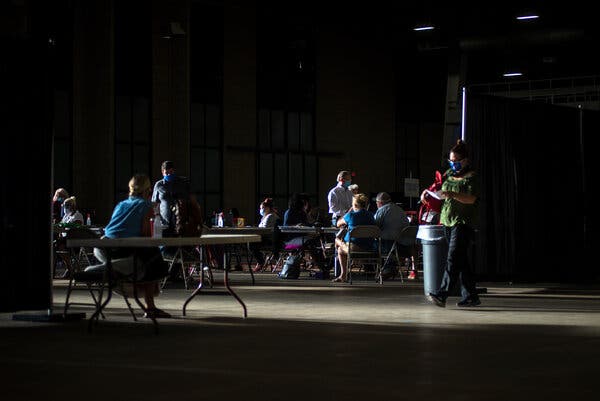When hundreds of thousands of children in the nation’s largest school system stream back into school buildings this week for the first time since March 13, they will find their schools and classrooms transformed.
New York City is the only major school district in America restarting in-person classes this month, and that herculean task has not unfolded entirely as planned. Mayor Bill de Blasio has twice delayed the start of in-person classes for most students. And on Sunday, the union representing the city’s principals called on the state to take over the reopening effort from Mr. de Blasio.
Under the latest reopening plan, some young children and students with advanced disabilities returned to schools last week, and classrooms will be open for the rest of the system this week.
Almost no students will attend school five days a week. Instead, children who opt for in-person classes will report to classrooms one to three days per week and learn from home the rest of the time.
Many of New York’s roughly 1,400 school buildings are about a century old, and the city has had to scramble to upgrade ventilation in buildings already in urgent need of repair. In some cases, that has meant prying open windows that have been shut for years.
Principals have spent months trying to figure out how to arrange their schedules so that students are learning the same material at roughly the same pace, no matter where they are.
And it is possible that all students could be sent home at any time, if there are small outbreaks in classrooms or school buildings, or if the city’s average test positivity rate ticks up to 3 percent, from about 1 percent now.
As the world moves toward another morbid threshold in the pandemic, a coronavirus death toll of one million, the countries where fatalities are increasing fastest remain spread out across the globe, with new hot spots constantly emerging.
The number of lives lost daily to the virus has been rising through most of August and September, reaching more than 5,000 in an average measured over seven days. As of Monday morning, the global death toll stood at 997,300, according to a New York Times database.
On Sunday, the caseload in India surpassed six million, and the country continued to lead in daily virus-related deaths, with about 7,700 over the most recent seven-day period. The United States is second, with more than 5,000, Brazil third with more than 4,800, and Mexico fourth with nearly 3,000. Those four countries account for more than half of the world’s total deaths from the virus, according to the Times database.
New hot spots are also emerging in smaller countries like Israel, which led the world in new cases per capita over the past week.
The pandemic continues to wreak havoc in South America, where countries including Argentina, Colombia and Peru are recording thousands of new cases daily along with some of the highest numbers of deaths per capita in the world.
With seasons changing, some countries that were hit hard by the virus in the spring and summer are beginning to shed lockdown policies, raising fears of future surges. In Europe, second waves of infections have already hit Britain, France and Spain.
Not only are businesses shedding workers, with America’s unemployed numbering roughly 13.6 million, but employers are also cutting expenses like health coverage, and projections of rising numbers of uninsured have grown bleak.
Tens of millions of people could lose their job-based insurance by the end of the year, said Stan Dorn, the director of the National Center for Coverage Innovation at Families USA, a consumer group in Washington, D.C. “The odds are we are on track to have the largest coverage losses in our history,” he said.
While estimates vary, a recent Urban Institute analysis of census data says at least three million Americans have already lost job-based coverage, and a separate analysis from Avalere Health predicts some 12 million will lose it by the end of this year. Both studies highlight the disproportionate effect on Black and Hispanic workers.
Many businesses have tried to keep their workers insured during the pandemic. Employers relied on government aid, including the Paycheck Protection Program authorized by Congress to ease the economic fallout, to pay for premiums through the spring and summer.
Government funding appears to have “prevented the economic crisis from becoming a coverage crisis right away,” said Leemore S. Dafny, a professor at Harvard Business School and one of the authors of a report last month looking at the pandemic’s effect on small business.
Describing those employers as “the proverbial canary in the coal mine,” the researchers say there could be significant coverage losses if insurers and lawmakers fail to act in the coming months. Nearly a third of small businesses surveyed in late June said they were not sure they could keep paying premiums beyond August, according to the report.

The 11-year-boy from the industrial city in southern India would be a fine addition to any classroom — just ask his teacher.
“Rahul’s a good student,” said N. Sundara Murthy. “His absorption power is very good. His vocabulary is very good. He has a high I.Q. He says he wants to be a doctor and he could do it, if he has the right facilities.”
But with his school closed because of the coronavirus, Rahul finds himself part of the swarm of children who pour into the street from his housing project bearing not backpacks or books but filthy plastic sacks, bound for another day rummaging garbage dumps in search of recyclable plastic. It pays pennies an hour.
“I hate it,” said Rahul.
In many parts of the developing world, school closures have put children on the streets. Families are desperate for money. Children are an easy source of cheap labor. While the United States and other developed countries debate the effectiveness of online schooling, hundreds of millions of children in poorer countries lack computers or the internet and have no schooling at all.
United Nations officials estimate that at least 24 million children will drop out and that millions could be sucked into work. Ten-year-olds are now mining sand in Kenya. Children the same age are chopping weeds on cocoa plantations in West Africa. In Indonesia, boys and girls as young as 8 are painted silver and pressed into service as living statues who beg for money.
The surge in child labor could erode the progress achieved in recent years in school enrollment, literacy, social mobility and children’s health.
“All the gains that have been made, all this work we have been doing, will be rolled back, especially in places like India,” said Cornelius Williams, a high-ranking UNICEF official.

India’s coronavirus caseload has surpassed six million, the country’s health ministry announced Monday, as infections continued to grow across the South Asian country of 1.3 billion people.
India has the world’s second-highest caseload after the United States and has recorded at least 95,540 deaths, including 1,039 deaths in the past 24 hours. The country has recorded an average of 83,000 new cases a day for the past week, down from more than 90,000 cases earlier in the month.
At least 76,000 police and paramilitary forces personnel in India have been infected by the virus, with at least 400 deaths, the local media reported on Monday.
During his monthly radio address over the weekend, Prime Minister Narendra Modi renewed his appeal for people to wear face masks when outside their homes.
-
A 61-year-old Afghan man died on Sunday in Greece, becoming the first resident of a Greek migrant reception facility to die of the virus. The man, a father of two, died in an Athens hospital. He had been living in the Malakasa camp near the city, a Greek Migration Ministry official said, adding that his two children have been tested and are isolated within the camp. Malakasa is one of nine migrant reception facilities on the mainland that are locked down because of virus outbreaks.
-
A cruise ship carrying more than 1,500 people was turned back from the Greek island of Milos in the Aegean Sea after 12 crew members tested positive for the virus, a Greek Shipping Ministry official said. The Mein Schiff 6, which sails under the flag of Malta, left Crete on Sunday and was off the coast of Milos early on Monday when the test results were released, the official said.
-
The next Group of 20 summit meeting, which was scheduled to be held in Riyadh, Saudi Arabia, will take place virtually on Nov. 21 and 22, the kingdom said in a statement on Monday. Saudi Arabia, which holds the group’s rotating presidency, also hosted an emergency virtual summit meeting in March in response to the pandemic.
— Niki Kitsantonis and



















